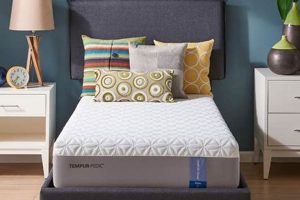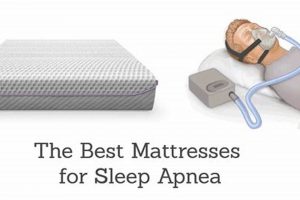A sleep surface enhancement made from natural or synthetic latex, typically two to four inches thick, is designed to be placed atop an existing mattress. This layer aims to alter the firmness and feel of the underlying mattress, potentially improving comfort and support. For instance, a firmer mattress might be softened with a plush latex addition, or a sagging mattress can be given a more supportive, resilient surface.
The selection of such an addition can significantly impact sleep quality, potentially alleviating pressure points, improving spinal alignment, and regulating temperature. Latex, known for its durability and breathability, provides a buoyant and responsive feel. The material has gained prominence as a bedding component due to its inherent properties, offering an alternative to traditional memory foam or fiberfill options. Historically, latex use in mattresses stems from the mid-20th century, evolving with advancements in processing and material science to offer varied densities and formulations.
The subsequent sections will delve into the factors influencing the selection of a latex sleep surface addition, including latex types, density considerations, thickness options, and certifications to consider. An evaluation of the potential benefits and drawbacks will further inform the consumer. This analysis will allow for a more comprehensive understanding of how to choose one that best suits individual needs and preferences.
Tips for Evaluating a Latex Mattress Topper
Selecting a latex mattress topper requires careful consideration of several factors to ensure optimal comfort and support. The following tips offer guidance in navigating the selection process.
Tip 1: Investigate Latex Type: Distinguish between Dunlop and Talalay latex. Dunlop tends to be denser and firmer, while Talalay is typically softer and more consistent. Natural latex should be prioritized for its eco-friendliness and durability compared to synthetic alternatives.
Tip 2: Assess Density: Density, measured in pounds per cubic foot (PCF), influences firmness and support. Lower densities (2-4 PCF) offer a softer feel, while higher densities (6+ PCF) provide firmer support. Match the density to individual sleep preferences and body weight.
Tip 3: Consider Thickness: Topper thickness significantly impacts the degree of comfort modification. Thicker options (3-4 inches) provide a more substantial change to the existing mattress feel, while thinner options (1-2 inches) offer a subtle adjustment.
Tip 4: Examine ILD Rating: Indentation Load Deflection (ILD) measures firmness. A lower ILD indicates a softer surface, while a higher ILD indicates a firmer surface. This metric, when available, provides a quantitative measure of the topper’s feel.
Tip 5: Check for Certifications: Look for certifications such as Oeko-Tex, GOLS (Global Organic Latex Standard), or CertiPUR-US. These certifications ensure the latex is free from harmful chemicals and meets specific environmental and safety standards.
Tip 6: Evaluate Support and Pressure Relief: A quality latex topper should provide adequate support to maintain spinal alignment and alleviate pressure points, particularly in the shoulders and hips. Consider body weight and sleeping position when assessing support.
Tip 7: Review Breathability: Latex is naturally breathable, but construction methods can impact airflow. Look for toppers with pinholes or open-cell structures to enhance ventilation and temperature regulation.
Selecting the right latex sleep surface addition can significantly improve sleep quality by customizing mattress feel and enhancing support. Careful evaluation of latex type, density, thickness, certifications, and breathability ensures a well-informed purchase.
The subsequent sections will provide further insights into maintenance and care, maximizing the lifespan of this investment.
1. Material Density
Material density, measured in pounds per cubic foot (PCF), is a critical determinant in the performance and feel of a latex mattress topper. It directly influences the topper’s firmness, support, and durability, thereby playing a significant role in determining its suitability for individual needs.
- Firmness Determination
Higher density latex toppers exhibit greater firmness. A topper with a density of 6 PCF or higher will generally provide a firmer surface, suitable for individuals requiring enhanced support, such as those with back pain. Conversely, lower density options (e.g., 4 PCF) offer a softer feel, catering to sleepers who prioritize pressure relief.
- Support Provision
Density directly correlates with the level of support offered. A high-density topper prevents excessive sinking, maintaining spinal alignment. This is especially important for side sleepers who require adequate support for their hips and shoulders. Insufficient density may lead to postural issues over time.
- Durability and Longevity
Increased density typically translates to enhanced durability. High-density latex is more resistant to compression and deformation over prolonged use. Lower density toppers are more prone to sagging and may require replacement sooner, affecting long-term value.
- Responsiveness
While higher density generally implies reduced responsiveness, the type of latex processing (Dunlop vs. Talalay) also influences this characteristic. Dunlop latex, typically denser, may feel less immediately responsive compared to Talalay latex of similar density. However, both offer a buoyant, supportive feel, distinct from memory foam.
In conclusion, material density is a primary consideration in the selection process. The ideal density balances comfort, support, and durability in alignment with individual sleep preferences and physical requirements. Selecting a density appropriate to body weight, sleeping position, and desired level of firmness will directly influence the overall satisfaction with a latex mattress topper. The selection should also consider the long-term impact of density on the product’s lifespan and performance.
2. ILD Rating
Indentation Load Deflection (ILD) rating serves as a quantitative measure of firmness in latex mattress toppers, offering a standardized method for evaluating the support characteristics of the material. Its relevance lies in enabling consumers to make informed decisions based on objective data, correlating ILD values with subjective comfort preferences.
- Defining Firmness Preferences
ILD ratings provide a tangible scale for understanding firmness levels. A lower ILD value indicates a softer feel, often preferred by individuals who sleep on their sides and require greater pressure relief. Conversely, a higher ILD valu
e denotes a firmer surface, typically favored by back and stomach sleepers seeking enhanced support and spinal alignment. The ILD value assists in translating subjective feelings into quantifiable data. - Comparing Products Objectively
Variations exist in subjective interpretations of firmness among different manufacturers. The ILD rating mitigates this ambiguity, offering a consistent benchmark for comparing diverse products. For instance, two toppers described as “medium-firm” may possess differing ILD values, revealing subtle yet significant distinctions in their actual support characteristics. This standardization facilitates accurate product comparisons.
- Predicting Support Performance
The ILD rating enables prediction of a topper’s ability to provide adequate support for individuals of varying body weights and sleeping positions. Higher body weights necessitate higher ILD values to prevent excessive sinking and maintain proper spinal alignment. Lighter individuals, conversely, may find lower ILD values more comfortable and supportive, as they require less resistance to achieve optimal spinal posture. The ILD rating therefore connects weight and sleeping position to topper performance.
- Accounting for Material Variability
Natural materials such as latex exhibit inherent variability. ILD ratings provide a means of controlling for these variations, ensuring that the final product meets defined performance criteria. Batch testing, utilizing ILD measurements, ensures that individual toppers fall within acceptable firmness ranges. This standardization is critical in maintaining consistent product quality and customer satisfaction.
The ILD rating serves as a crucial tool in navigating the selection process. By providing a standardized, objective measure of firmness, it enables consumers to align their subjective preferences with quantifiable data, ultimately improving the likelihood of selecting a product that optimizes comfort, support, and sleep quality. The use of ILD ratings in conjunction with other factors, such as density and material type, facilitates a more comprehensive assessment of a latex mattress topper’s performance characteristics.
3. Thickness Options
The thickness of a latex mattress topper directly influences its impact on the sleep surface and, consequently, its overall suitability. Thickness options typically range from one to four inches, each providing a distinct level of alteration to the existing mattress feel. A thinner profile, such as one or two inches, primarily offers a subtle enhancement to the mattress, providing a minor adjustment to firmness and pressure relief. For instance, a one-inch topper might slightly soften a mattress that is too firm, without fundamentally changing its support characteristics. In contrast, a thicker profile, such as three or four inches, allows for a more substantial alteration to the sleep surface. This is particularly relevant for individuals seeking to significantly change the feel of their mattress, perhaps to compensate for sagging or to drastically alter the firmness level. For example, a four-inch topper can transform a very firm mattress into a softer, more pressure-relieving sleep surface.
The choice of thickness should correlate with the existing mattress condition and the desired outcome. If the underlying mattress offers adequate support but lacks comfort, a thinner topper may suffice. However, if the mattress lacks both support and comfort, a thicker topper is often necessary to provide a meaningful improvement. Furthermore, body weight and sleeping position influence the ideal thickness. Heavier individuals generally require thicker toppers to prevent bottoming out and maintain adequate support. Similarly, side sleepers benefit from thicker options to allow for sufficient contouring and pressure relief around the hips and shoulders. An inadequate thickness may negate the benefits of the latex material, failing to provide the desired level of comfort or support.
In conclusion, thickness is a critical parameter in selecting a latex mattress topper. Its significance stems from its direct impact on the degree to which the topper alters the feel and support of the existing mattress. Careful consideration of the existing mattress condition, body weight, sleeping position, and desired outcome is essential in determining the appropriate thickness. Opting for an ill-suited thickness can undermine the benefits of the latex material, leading to dissatisfaction. Therefore, thickness should be viewed as a foundational component in selecting a sleep surface addition.
4. Natural vs. Synthetic
The distinction between natural and synthetic latex is a fundamental consideration when evaluating the suitability of a latex mattress topper. This differentiation affects not only the inherent properties of the topper but also its durability, environmental impact, and overall performance. Natural latex, derived from the sap of rubber trees, possesses inherent resilience and breathability, contributing to a comfortable and supportive sleep environment. Its cellular structure promotes airflow, mitigating heat retention and enhancing temperature regulation. Synthetic latex, typically produced from petrochemicals, often lacks these natural advantages. While it can mimic some of the properties of natural latex, it may be less durable, less breathable, and potentially emit volatile organic compounds (VOCs). For example, a natural latex topper may last significantly longer and provide superior temperature regulation compared to a synthetic counterpart, directly impacting sleep quality and product lifespan.
The selection between natural and synthetic latex also carries implications for health and environmental responsibility. Natural latex is considered a more sustainable choice, as it is derived from a renewable resource and requires fewer chemical processes in its production. Synthetic latex production, conversely, relies on fossil fuels and can contribute to environmental pollution. Furthermore, individuals with latex allergies should exercise caution when selecting a mattress topper, as both natural and synthetic latex can trigger allergic reactions, although the risk is generally lower with properly processed natural latex. The processing method significantly affects the presence of allergenic proteins. For instance, the Dunlop process tends to retain more proteins, whereas the Talalay process washes out more proteins, potentially reducing allergenicity.
Ultimately, the choice between natural and synthetic latex involves weighing the benefits and drawbacks of each material. While synthetic latex may offer a more cost-effective option, it often compromises on durability, breathability, and environmental sustainability. Natural latex, although generally more expensive, provides superior performance and aligns with environmentally conscious purchasing decisions. Consumers should consider their individual priorities, including budget, health concerns, and environmental values, when determining the optimal material for their sleep surface addition. Proper research into the source and processing of the latex is essential to making an informed decision that aligns with both comfort preferences and long-term health and environmental considerations.
5. Certification Standards
Certification standards serve as independent verification systems that assess latex mattress toppers against established criteria, ensuring adherence to specific quality, safety, and environmental guidelines. These standards provide consumers with a means of evaluating product claims and making informed purchasing decisions. The presence of relevant certifications indicates that a product has undergone rigorous testing and meets defined benchmarks.
- GOLS (Global Organic Latex Standard) Certification
This standard specifically addresses latex products, verifying that the raw materials originate from certified organic rubber tree plantations and that the manufacturing process adheres to stringent environmental and social criteria. The GOLS certification ensures that the latex used in the mattress topper is free from harmful substances and produced in an environmentally responsible manner. The GOLS certification is a key indicator of a product’s sustainability and environmental impact.
- Oeko-Tex Standard 100 Certification
This certification focuses on the human-ecological safety of textile products. It tests for harmful substances, such as formaldehyde, pesticides, and heavy metals, ensuring that the latex mattress topper is safe for direct skin contact. Oeko-Tex Standard 100 certification provides assurance that the product is free from potentially allergenic or irritating substances, promoting a healthier sleep environment.
- CertiPUR-US Certification
Primarily applicable to polyurethane foam components, CertiPUR-US certification is relevant if a latex mattress topper incorporates polyurethane foam in its construction. It verifies that the foam is made without ozone depleters, certain flame retardants, heavy metals, formaldehyde, and phthalates. CertiPUR-US certification ensures that the topper meets specific standards for emissions and content, contributing to improved indoor air quality.
- Eco-INSTITUT Certification
This certification evaluates products for emissions of volatile organic compounds (VOCs) and other harmful substances. It tests for a wide range of chemicals, including formaldehyde, benzene, and toluene, ensuring that the latex mattress topper meets stringent emission standards. Eco-INSTITUT certification is a valuable indicator of the product’s impact on indoor air quality and potential health effects.
The presence of one or more of these certification standards on a latex mattress topper serves as a validation of its quality, safety, and environmental responsibility. Consumers can leverage these certifications to differentiate between products and select an option that aligns with their specific requirements and values. The absence of relevant certifications may indicate a lack of adherence to industry best practices and should prompt further investigation into the product’s composition and manufacturing process.
6. Pinholes
Pinholes, small perforations intentionally introduced during the manufacturing of latex mattress toppers, directly influence the material’s breathability and overall comfort. The presence of pinholes facilitates air circulation within the latex, mitigating heat retention and promoting a cooler sleep environment. The density of pinholes per unit area impacts the effectiveness of this ventilation. A greater density correlates with improved airflow, while insufficient pinholes may result in heat buildup, detracting from the sleep experience. The absence of pinholes, particularly in denser latex formulations, often leads to noticeable heat retention, making them a critical feature in toppers intended for hot sleepers.
The manufacturing process determines the size and distribution of pinholes. Uniformly distributed pinholes maximize airflow across the entire surface, whereas inconsistent distribution can create localized hotspots. Some manufacturers employ automated processes to ensure even pinhole density, while others may rely on manual techniques that can introduce variability. This variability can affect the consistent performance of the topper in terms of temperature regulation. For example, a topper with uneven pinhole distribution may feel cooler in some areas and warmer in others, reducing overall comfort.
The inclusion of pinholes represents a design consideration aimed at enhancing the user experience. While small, these perforations contribute significantly to the breathable nature of latex, offsetting its inherent tendency to retain heat. This design element is particularly crucial in distinguishing high-quality toppers from less sophisticated alternatives. The presence and proper distribution of pinholes indicates a focus on thermal comfort, a critical factor in determining the overall effectiveness and user satisfaction.
7. Support Quality
The capacity of a sleep surface addition to maintain proper spinal alignment and evenly distribute body weight defines its support quality. This aspect is paramount when considering a latex mattress topper, as it directly impacts sleep comfort, musculoskeletal health, and overall well-being. The following facets explore the nuances of support quality in the context of latex mattress toppers.
- Spinal Alignment Maintenance
A primary function of adequate support is maintaining the natural curvature of the spine during sleep. A latex topper with sufficient support prevents excessive sinking, particularly in the hip and shoulder regions, which can lead to spinal misalignment and subsequent back pain. The “best latex mattress topper” will offer the correct level of resistance to maintain the spine’s neutral position, regardless of sleeping posture. Failing to maintain spinal alignment can exacerbate existing back conditions and lead to chronic discomfort.
- Pressure Point Reduction
Effective support minimizes concentrated pressure on specific body areas, such as the shoulders, hips, and knees. Latex, due to its inherent elasticity, conforms to the body’s contours, distributing weight more evenly. A topper that excels in pressure point reduction allows for improved circulation and reduced tossing and turning during sleep. For instance, a topper may alleviate pressure on the hips of a side sleeper, preventing discomfort and promoting uninterrupted sleep.
- Weight Distribution
Proper weight distribution is essential for preventing localized stress and ensuring balanced support across the entire body. A high-quality latex topper prevents any single area from bearing excessive weight, thus promoting even wear and extending the lifespan of both the topper and the underlying mattress. Uneven weight distribution can lead to premature sagging in certain areas, diminishing the overall effectiveness of the sleep system.
- Edge Support Contribution
While the primary support is provided across the main sleeping surface, edge support is also a consideration. A “best latex mattress topper” will, to some degree, extend its supportive properties to the edges, preventing a feeling of roll-off and providing a more usable sleep surface. Enhanced edge support translates to a more consistent level of comfort and support, regardless of proximity to the mattress perimeter.
These interconnected f
acets of support quality define the effectiveness of a latex mattress topper. Selecting a topper that adequately addresses spinal alignment, pressure point reduction, weight distribution, and edge support will yield the most significant improvements in sleep comfort and overall musculoskeletal health. The capacity of the chosen topper to deliver these aspects consistently determines its value and contribution to a restful night’s sleep. The integration of these support elements directly correlates with the designation of a product as a “best latex mattress topper,” as it provides tangible benefits to the sleeper.
Frequently Asked Questions
The following questions address common concerns and misconceptions regarding the selection and use of latex mattress toppers. These responses aim to provide clear and informative guidance.
Question 1: What distinguishes Dunlop and Talalay latex, and how does this impact topper selection?
Dunlop latex is produced through a single-pour process, resulting in a denser, firmer material. Talalay latex undergoes a multi-step process, including vacuum sealing and flash freezing, resulting in a more consistent and less dense material. Dunlop is often preferred for support, while Talalay offers enhanced pressure relief.
Question 2: How does topper density influence its suitability for different body weights and sleeping positions?
Higher density toppers (6 PCF+) provide greater support and are generally recommended for heavier individuals and those who sleep on their back or stomach. Lower density toppers (2-4 PCF) offer more cushioning and are suitable for lighter individuals and side sleepers.
Question 3: What is the significance of ILD (Indentation Load Deflection) ratings when evaluating latex mattress toppers?
ILD rating quantifies the firmness of a topper. Lower ILD values indicate a softer surface, while higher values denote a firmer surface. This metric allows for objective comparisons between products, beyond subjective descriptions of firmness.
Question 4: Are there potential drawbacks to using a latex mattress topper, and how can these be mitigated?
Potential drawbacks include off-gassing (particularly with synthetic blends), heat retention (especially with denser formulations), and the potential for allergic reactions. Off-gassing can be minimized by airing out the topper before use. Heat retention can be addressed with pinhole designs. Allergies can be managed by choosing certified natural latex and using a protective cover.
Question 5: How should a latex mattress topper be maintained to maximize its lifespan?
Regularly rotating the topper can prevent uneven wear. Protecting it with a mattress protector shields it from spills and stains. Avoid direct sunlight and harsh chemicals, as these can degrade the latex. Spot clean as needed with a mild detergent.
Question 6: What certifications are relevant when assessing the safety and environmental impact of a latex mattress topper?
Relevant certifications include GOLS (Global Organic Latex Standard), Oeko-Tex Standard 100, and CertiPUR-US. These certifications verify that the product meets specific standards for organic content, chemical emissions, and overall safety.
In summary, the selection of a latex mattress topper necessitates careful consideration of latex type, density, ILD rating, potential drawbacks, maintenance requirements, and relevant certifications. Informed decision-making promotes both comfort and long-term satisfaction.
The subsequent section explores the practical considerations involved in purchasing and installing a latex mattress topper.
Conclusion
The preceding analysis has explored the critical factors in determining the suitability of a latex mattress topper, encompassing material properties, construction methods, and certification standards. Density, ILD rating, and thickness represent key performance indicators that directly influence sleep quality. A differentiation between natural and synthetic latex has underscored the importance of material sourcing and potential environmental impact. Furthermore, the role of certifications in validating safety and quality claims has been highlighted as a critical component in the decision-making process. A topper which fails to meet requirements may not be considered the “best latex mattress topper”.
The selection of a sleep surface addition demands a comprehensive understanding of individual needs and preferences. The information provided serves as a guide for consumers seeking to optimize their sleep environment through a well-informed purchase. Continued advancements in material science and manufacturing techniques are expected to further refine the options available, underscoring the need for ongoing research and critical evaluation.


![Top Rated: Best Infant Mattress [Guide & Reviews] Organic & Natural Mattress Buyer’s Guide: Non-Toxic Sleep Solutions Top Rated: Best Infant Mattress [Guide & Reviews] | Organic & Natural Mattress Buyer’s Guide: Non-Toxic Sleep Solutions](https://mattressworldpa.com/wp-content/uploads/2025/07/th-7676-300x200.jpg)


![Top Best Mattress Brands of [Year]: Sleep Soundly! Organic & Natural Mattress Buyer’s Guide: Non-Toxic Sleep Solutions Top Best Mattress Brands of [Year]: Sleep Soundly! | Organic & Natural Mattress Buyer’s Guide: Non-Toxic Sleep Solutions](https://mattressworldpa.com/wp-content/uploads/2025/07/th-7673-300x200.jpg)

